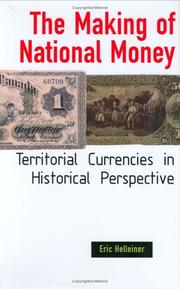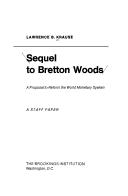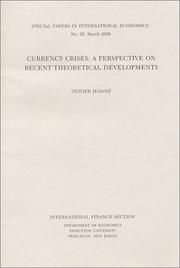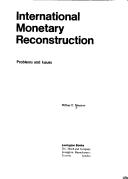Book
ISBN: 1944424458 9781944424459 9781944424442 Year: 2017 Publisher: Cato Institute
Abstract | Keywords | Export | Availability | Bookmark
 Loading...
Loading...Choose an application
- Reference Manager
- EndNote
- RefWorks (Direct export to RefWorks)
Currency question --- Money --- Currency --- Monetary question --- Money, Primitive --- Specie --- Standard of value --- Exchange --- Finance --- Value --- Banks and banking --- Coinage --- Gold --- Silver --- Silver question --- Wealth --- Fiat money --- Free coinage --- Scrip --- Currency crises --- Finance, Public --- Legal tender --- E-books --- Currency question. --- Money.

ISBN: 1501720724 9781501720727 0801440491 9780801440496 Year: 2018 Publisher: Ithaca, NY : Cornell University Press,
Abstract | Keywords | Export | Availability | Bookmark
 Loading...
Loading...Choose an application
- Reference Manager
- EndNote
- RefWorks (Direct export to RefWorks)
Why should each country have its own exclusive currency? Eric Helleiner offers a fascinating and unique perspective on this question in his accessible history of the origins of national money. Our contemporary understandings of national currency are, Helleiner shows, surprisingly recent. Based on standardized technologies of production and extraction, territorially exclusive national currencies emerged for the first time only during the nineteenth century. This major change involved a narrow definition of legal tender and the exclusion of tokens of value issued outside the national territory. "Territorial currencies" rapidly became bound up with the rise of national markets, and money reflected basic questions of national identity and self-presentation: In what way should money be managed to serve national goals? Whose pictures should go on the banknotes? Helleiner draws out the potent implications of this largely unknown history for today's context. Territorial currencies face challenges from many monetary innovations-the creation of the euro, dollarization, the spread of local currencies, and the prospect of privately issued electronic currencies. While these challenges are dramatic, the author argues that their significance should not be overstated. Even in their short historical life, territorial currencies have never been as dominant as conventional wisdom suggests. The future of this kind of currency, Helleiner contends, depends on political struggles across the globe, struggles that echo those at the birth of national money.
Currency question. --- Money --- Money. --- Currency --- Monetary question --- Money, Primitive --- Specie --- Standard of value --- Exchange --- Finance --- Value --- Banks and banking --- Coinage --- Currency question --- Gold --- Silver --- Silver question --- Wealth --- Fiat money --- Free coinage --- Scrip --- Currency crises --- Finance, Public --- Legal tender --- Political aspects.
Book
ISBN: 9780691137940 9781400846856 1400846854 0691137943 Year: 2008 Publisher: Princeton Princeton University Press
Abstract | Keywords | Export | Availability | Bookmark
 Loading...
Loading...Choose an application
- Reference Manager
- EndNote
- RefWorks (Direct export to RefWorks)
Friedman and Schwartz's A Monetary History of the United States, 1867-1960, published in 1963, stands as one of the most influential economics books of the twentieth century. A landmark achievement, the book marshaled massive historical data and sharp analytics to support the claim that monetary policy--steady control of the money supply--matters profoundly in the management of the nation's economy, especially in navigating serious economic fluctuations. The chapter entitled "The Great Contraction, 1929-33" addressed the central economic event of the century, the Great Depression. Published as a stand-alone paperback in 1965, The Great Contraction, 1929-1933 argued that the Federal Reserve could have stemmed the severity of the Depression, but failed to exercise its role of managing the monetary system and ameliorating banking panics. The book served as a clarion call to the monetarist school of thought by emphasizing the importance of the money supply in the functioning of the economy--a concept that has come to inform the actions of central banks worldwide. This edition of the original text includes a new preface by Anna Jacobson Schwartz, as well as a new introduction by the economist Peter Bernstein. It also reprints comments from the current Federal Reserve chairman, Ben Bernanke, originally made on the occasion of Milton Friedman's 90th birthday, on the enduring influence of Friedman and Schwartz's work and vision.
Business cycles --- anno 1920-1929 --- anno 1930-1939 --- United States --- Monetary policy --- Currency question --- Money --- Fiat money --- Free coinage --- Monetary question --- Scrip --- Currency crises --- Finance --- Finance, Public --- Legal tender --- History. --- United States of America
Book
ISBN: 9789811928482 Year: 2022 Publisher: Singapore Springer Nature Singapore :Imprint: Palgrave Macmillan
Abstract | Keywords | Export | Availability | Bookmark
 Loading...
Loading...Choose an application
- Reference Manager
- EndNote
- RefWorks (Direct export to RefWorks)
What is money, where does it come from, what is its purpose? Does it increase national and international inequalities? Rémy Herrera's book analyzes how the changes in the capitalist world system have consolidated, over the last decades, the supremacy of the U.S. dollar, but also how this hegemony has recently been challenged, both by rising State resistance initiatives and by the emergence of crypto-currencies, which raises many questions. Reviewing the situation of each continent, this book invites us to debate the liberation from the dollar domination, as well as the future of the euro, that of the CFA and CFP francs, of the Cuban peso or of the Chinese yuan, among others, but also the means to take in hand our collective future by mastering money. Rémy Herrera is a French economist, researcher at the CNRS (Centre national de la Recherche scientifique, National Center of Scientific Research). He has worked in financial auditing and in international institutions, including the OECD and the World Bank. He is the author of numerous books and scientific articles on economics, and teaches in several universities, especially at the Centre d'Économie de la Sorbonne. He regularly collaborates with the CETIM (Center Europe Third World), notably by supporting it in its advisory role with the United Nations.
Currency question. --- Money. --- Currency --- Monetary question --- Money, Primitive --- Specie --- Standard of value --- Exchange --- Finance --- Value --- Banks and banking --- Coinage --- Currency question --- Gold --- Silver --- Silver question --- Wealth --- Fiat money --- Free coinage --- Scrip --- Currency crises --- Finance, Public --- Legal tender --- Money
Book
ISBN: 1280004541 9786610004546 0585261288 Year: 1998 Publisher: Washington, DC : World Bank,
Abstract | Keywords | Export | Availability | Bookmark
 Loading...
Loading...Choose an application
- Reference Manager
- EndNote
- RefWorks (Direct export to RefWorks)
Finance --- Financial institutions --- Currency question --- Financial Management & Planning --- Business & Economics --- Fiat money --- Free coinage --- Monetary question --- Scrip --- Currency crises --- Finance, Public --- Legal tender --- Money --- Financial intermediaries --- Lending institutions --- Associations, institutions, etc. --- East Asia --- Economic policy.
Periodical
Abstract | Keywords | Export | Availability | Bookmark
 Loading...
Loading...Choose an application
- Reference Manager
- EndNote
- RefWorks (Direct export to RefWorks)
Finance --- International finance --- Currency question --- Finances internationales --- Question monétaire --- Periodicals. --- Périodiques --- -Currency question --- -332.1505 --- Fiat money --- Free coinage --- Monetary question --- Scrip --- Currency crises --- Finance, Public --- Legal tender --- Money --- International monetary system --- International money --- International economic relations --- Periodicals --- #ETEW:TSCAT --- #A33625 --- GB / United Kingdom - Verenigd Koninkrijk - Royaume Uni --- Published Quarterly --- Question monétaire --- Périodiques

ISBN: 0815750358 9780815750352 Year: 1971 Publisher: Washington (D.C.): Brookings institution
Abstract | Keywords | Export | Availability | Bookmark
 Loading...
Loading...Choose an application
- Reference Manager
- EndNote
- RefWorks (Direct export to RefWorks)
International finance --- Currency question --- 339.73 --- Fiat money --- Free coinage --- Monetary question --- Scrip --- Currency crises --- Finance --- Finance, Public --- Legal tender --- Money --- Organisatie van internationaal betalingsverkeer. Bretton woods. --- 339.73 Organisatie van internationaal betalingsverkeer. Bretton woods. --- International monetary system --- International money --- International economic relations --- Organisatie van internationaal betalingsverkeer. Bretton woods

ISBN: 0881653098 Year: 2000 Publisher: Princeton, N.J.
Abstract | Keywords | Export | Availability | Bookmark
 Loading...
Loading...Choose an application
- Reference Manager
- EndNote
- RefWorks (Direct export to RefWorks)
International finance --- Currency question --- Foreign exchange --- Financial crises --- 332.456 --- Crashes, Financial --- Crises, Financial --- Financial crashes --- Financial panics --- Panics (Finance) --- Stock exchange crashes --- Stock market panics --- Crises --- Business cycles --- Cambistry --- Currency exchange --- Exchange, Foreign --- Foreign currency --- Foreign exchange problem --- Foreign money --- Forex --- FX (Finance) --- International exchange --- Currency crises --- Fiat money --- Free coinage --- Monetary question --- Scrip --- Finance --- Finance, Public --- Legal tender --- Money --- Crises monetaires

ISBN: 0669925519 Year: 1974 Publisher: Lexington Heath
Abstract | Keywords | Export | Availability | Bookmark
 Loading...
Loading...Choose an application
- Reference Manager
- EndNote
- RefWorks (Direct export to RefWorks)
339.73 --- Currency question --- Monetary policy --- Monetary management --- Economic policy --- Currency boards --- Money supply --- Fiat money --- Free coinage --- Monetary question --- Scrip --- Currency crises --- Finance --- Finance, Public --- Legal tender --- Money --- Organisatie van internationaal betalingsverkeer. Bretton woods. --- International finance --- 339.73 Organisatie van internationaal betalingsverkeer. Bretton woods. --- International monetary system --- International money --- International economic relations --- Organisatie van internationaal betalingsverkeer. Bretton woods
Book
ISBN: 1848552602 9786613681928 1280771151 1848552610 9781848552616 Year: 2009 Publisher: Bingley : Emerald,
Abstract | Keywords | Export | Availability | Bookmark
 Loading...
Loading...Choose an application
- Reference Manager
- EndNote
- RefWorks (Direct export to RefWorks)
This is a new volume in the successful and long-running CEA Series. The Asian Economy with one common Asian Money is a frontier topic of study in supranational macroeconomics. If the Europeanization of Europe has become a historic reality, the Asianization of Asia cannot be far behind. The paradigm of the European Union (EU) has become a learning model for other continents, especially Asia. In Asia, the process was initiated following the Asian financial crisis of 1997-98, when several newly industrialized Asian economies suffered negative rates of growth of gross domestic product (GDP).The three (Japan, China, and Korea) plus five (Singapore, Malaysia, Thailand, Indonesia, and the Philippines) came together to became the core members of a new regional group. Their annual meetings became an institutional feature of Asian economic cooperation and regional economic integration. In 2003, the group expanded to become the four (Japan, China, Korea, and India) plus 10 model (the original five plus Myanmar, Cambodia, Laos, Brunei Darussalam, and Viet Nam). The book examines the prospects of, the justification for, and the implications of the development of a common Asian currency.
Asia -- Economic integration. --- Asia -- Economic policy. --- Asia -- Monetary policy. --- Currency question -- Asia. --- Monetary unions -- Asia. --- Currency question --- Monetary unions --- Monetary policy --- Asia --- Economic integration. --- Economic policy. --- Common currencies --- Currency areas --- Currency unions --- Optimum currency areas --- Fiat money --- Free coinage --- Monetary question --- Scrip --- Money --- Currency crises --- Finance --- Finance, Public --- Legal tender --- E-books --- Business & Economics --- Monetary economics. --- Money & Monetary Policy. --- Foreign Exchange. --- Economic conditions.

 Search
Search Feedback
Feedback About
About Help
Help News
News